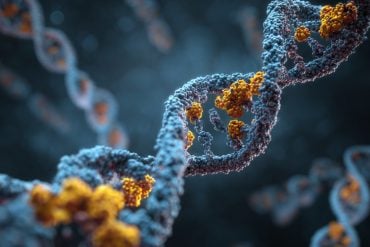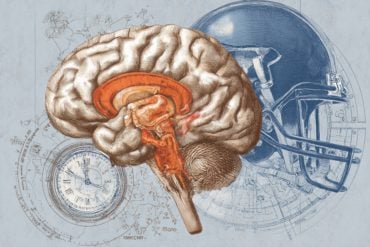Summary: A new study reveals prenatal cannabis exposure can cause behavioral and neural deficits in male offspring. Researchers say male rats exposed to marijuana in virto were less sociable than normal animals.
Source: Elife.
Taking cannabinoids during pregnancy can cause behavioural and neuronal deficits in adult male offspring, while females remain unaffected, says new research published in eLife.
The study in rats, from the Inserm and Aix-Marseille University Mediterranean Institute of Neurobiology, France, and Roma Tre University, Italy, in collaboration with Indiana University, US, suggests that prenatal cannabinoid use can lead to less sociability and increased neuronal excitability in males only. The findings also point towards a potential pharmacological strategy to help reverse these effects in humans.
Senior author Olivier Manzoni, Inserm Research Director at the Mediterranean Institute of Neurobiology, and Director of the CannaLab at the institute, says: “As cannabinoids can cross the placenta, they may interfere with fetal endocannabinoid signaling during neurodevelopment, which is involved in regulating a variety of processes such as pregnancy, appetite, pain sensation, and mediating the pharmacological effects of cannabis. This could in turn lead to some serious long-term deficits. But despite increasing reports of cannabis consumption during pregnancy, the long-term consequences of prenatal cannabinoid exposure remain incompletely understood.”
To fill this knowledge gap, the international collaborators examined how prenatal cannabinoid exposure influences the synaptic and behavioral functions of the medial prefrontal cortex – a brain region often implicated in neuropsychiatric disorders – in adult male and female rats.
Their results revealed that males exposed to cannabinoids while in the uterus were less sociable than normal animals, and spent less time interacting with others. Their sniffing and playing behaviors were impaired, while the number of attacks among males remained unchanged. Additionally, the researchers saw that the exposed males had a heightened excitability of pyramidal neurons in the prefrontal cortex. None of these effects were seen in females.
“The deleterious effects of prenatal exposure to cannabinoids on social behavior were specific to male offspring only,” explains co-first author Anissa Bara, who was a PhD candidate in Manzoni’s lab at the time the study was carried out. “But while social interaction was specifically impaired in males, locomotion, anxiety and cognition remained unaffected in both sexes, suggesting discrete and sex-specific behavioral consequences of cannabinoid exposure during adulthood.”

The results also revealed that the mGlu5 gene – an effector of endocannabinoid signaling in the prefrontal cortex – was reduced in the exposed males’ prefrontal cortex. The team discovered that amplifying mGlu5 signaling could normalise the synaptic and behavioral deficits induced by prenatal exposure to cannabinoids partly by activating the cannabinoid type 1 receptor (CB1R). Similarly, later tests also revealed that enhancing levels of anandamide (a type of endocannabinoid) in exposed males helped to restore their social deficits via CB1R.
“Altogether, these results provide compelling evidence for sex-specific effects of prenatal cannabinoid exposure,” concludes co-first author Antonia Manduca, Inserm Postdoctoral Researcher at the Mediterranean Institute of Neurobiology. “The fact that increasing mGlu5 signaling and enhancing anandamide levels helped to reverse the negative effects of early exposure in rats also hints at a new pharmacological strategy that could one day be trialled in humans.”
Source: Emily Packer – Elife
Publisher: Organized by NeuroscienceNews.com.
Image Source: NeuroscienceNews.com image is in the public domain.
Original Research: Abstract for “Sex-dependent effects of in utero cannabinoid exposure on cortical function” by Anissa Bara, Antonia Manduca, Axel Bernabeu, Milene Borsoi, Michela Serviado, Olivier Lassalle, Michelle N Murphy, Jim Wager-Miller, Ken Mackie, Anne-Laure Pelissier-Alicot, Viviana Trezza, and Olivier J Manzoni in eLife. Published September 11 2018.
doi:10.7554/eLife.36234
[cbtabs][cbtab title=”MLA”]Elife”Prenatal Exposure to Cannabis Impacts Sociability in Male Offspring Only.” NeuroscienceNews. NeuroscienceNews, 11 September 2018.
<https://neurosciencenews.com/cannabis-male-sociability-9840/>.[/cbtab][cbtab title=”APA”]Elife(2018, September 11). Prenatal Exposure to Cannabis Impacts Sociability in Male Offspring Only. NeuroscienceNews. Retrieved September 11, 2018 from https://neurosciencenews.com/cannabis-male-sociability-9840/[/cbtab][cbtab title=”Chicago”]Elife”Prenatal Exposure to Cannabis Impacts Sociability in Male Offspring Only.” https://neurosciencenews.com/cannabis-male-sociability-9840/ (accessed September 11, 2018).[/cbtab][/cbtabs]
Abstract
Sex-dependent effects of in utero cannabinoid exposure on cortical function
Cannabinoids can cross the placenta, thus may interfere with fetal endocannabinoid signaling during neurodevelopment, causing long-lasting deficits. Despite increasing reports of cannabis consumption during pregnancy, the protracted consequences of prenatal cannabinoid exposure (PCE) remain incompletely understood. Here we report sex-specific differences in behavioral and neuronal deficits in the adult progeny of rat dams exposed to low doses of cannabinoids during gestation. In males, PCE reduced social interaction, ablated endocannabinoid long-term depression (LTD) and heightened excitability of prefrontal cortex pyramidal neurons, while females were spared. Group 1 mGluR and endocannabinoid signaling regulate emotional behavior and synaptic plasticity. Notably, sex-differences following PCE included levels of mGluR1/5 and TRPV1R mRNA. Finally, positive allosteric modulation of mGlu5 and enhancement of anandamide levels restored LTD and social interaction in PCE adult males. Together, these results highlight marked sexual differences in the effects of PCE and introduce strategies for reversing detrimental effects of PCE.






